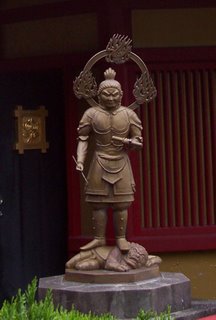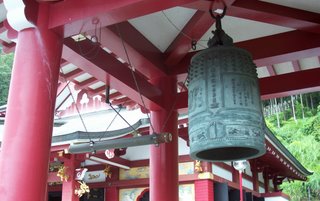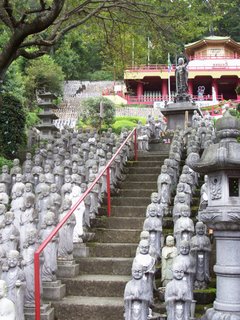Usami Kannon
Just north of Ito is a small suburb named Usami. When you are on the beachfront road in Ito (route 135), you can see a huge statue way up on a mountain that stands out as it is surrounded by forest. Today, I drove up there with Blaise, a guy who is in town visiting his girlfriend, Aura, who is a JET in Usami. The road to the statue is curvy and goes all the way up the mountain.
Presently, we arrived at the temple of Usami Kannon, who I learned is a Buddhist/Hindu hybrid of the Goddess of compassion and mercy. The temple was not enormous, but the grounds were. The whole place was filled with thousands of statues lined up all over. Each statue has a number on it. I can only assume that families buy a statue as a tribute to the dead or as a prayer for good fortune, and they decorate them. Addorning the trees and pretty much any small twig or wire are little pieces of paper tied in an overhand knot. I learned later that these are wishes for good fortune tied by the many Japanese people who visit this temple.
There are bas reliefs inside the temple buildings that have a very Indian/Thai look to them, as do many of the statues on the grounds. Apparently, the Buddhist and Hindu religions merged when they left India, and then commingled with the local religions of East Asia, making the modern product in Japan dificult to discern from where each symbol comes. The tour cost 300 Yen (about $3 US) and took about 20 minutes.
Here are some pictures: 

Here is one of the many sculptures at the temple. I'm not sure whether it represents a person or a god, but there were four of them on each of the corners of this building, each with something diferent in his hands, a sword, a quill and paper, etc. I couldn't see the other two up close because they were on the outer edge of the building. UPDATE--These guys are four kings who guard the cardinal directions and are protectors of Buddhist Law (Dharma). They are called Shitenno, and are part of the Deva class (the Japanese call them Tenbu--celestial beings)--Hindu gods and creatures who were enlightened by Buddhism. You can see here that the warriors stand atop demons called Jyaki.
This image shows a large Buddha surounded by some of the thousands of miniatures. Unfortunately, I couldn't get a photo that shows how overwhelming it was to be surrounded by these.
This fellow looks very jolly. I wonder if that's a barrel for beer in his hand. Note that many of the statues have enormous earlobes. I'm not sure what that symbolizes. UPDATE--This is most likely Hotei, god of contentment and happiness. The bag over his shoulder never empties as he feeds the poor with it. He is commonly known in the West as the fat Buddha or the laughing Buddha.
This is the view from the top of the mountain of Usami and the bay on which Ito and Usami sit. Breathtaking.
These are the Shichifukujin--the 7 gods of good fortune in Japan. More on them at http://www.onmarkproductions.com/html/seven.shtml. There are smaller versions of these down in the Ito marketplace, and each has a fountain with a ladle so that you may pour water on their heads for a blessing.
Here is a view of the 150+ foot tall Usami Kannon. I was impressed with the way they captured the look of serenity in stone. Looking up from below, you really do start to feel as if everything is going to be ok. The whole place really tickled my Joseph Campbell bone, as I was noticing virgin birth themes all over the place, and there were many statues that resembled the many different images we have of the Virgin Mary. UPDATE--apparently, Kannon is more often represented as male, but in this and many other cases, is seen as a female. I have learned that this is fairly common in the Buddhist/Hindu tradition.
Finally, up on the top of the mountain, I found a very strange, but oddly familiar statue (of the Tenbu Pauli Gamobon) that I thought would be pleasing to your eyes as well. It would appear that even the Buddhists are Browns fans!








No comments:
Post a Comment